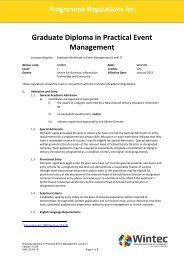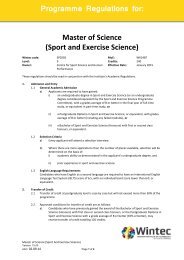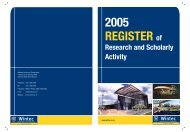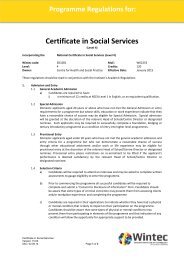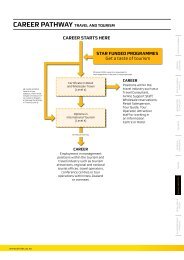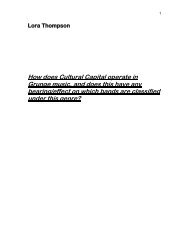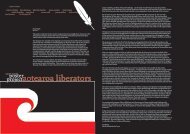Physiological analysis of the metabolic typing diet in professional ...
Physiological analysis of the metabolic typing diet in professional ...
Physiological analysis of the metabolic typing diet in professional ...
You also want an ePaper? Increase the reach of your titles
YUMPU automatically turns print PDFs into web optimized ePapers that Google loves.
orig<strong>in</strong>al<br />
research<br />
<strong>Physiological</strong> <strong>analysis</strong><br />
<strong>of</strong> <strong>the</strong> <strong>metabolic</strong> <strong>typ<strong>in</strong>g</strong><br />
<strong>diet</strong> <strong>in</strong> pr<strong>of</strong>essional rugby<br />
union players<br />
Address for Correspondence<br />
Andrea Braakhuis<br />
Waikato Institute <strong>of</strong><br />
Technology<br />
School <strong>of</strong> Sport & Exercise<br />
Science<br />
Avalon Drive<br />
Private Bag 3036<br />
Hamilton<br />
New Zealand 2020<br />
Telephone: +64 7 834 8800<br />
Ext: 8044<br />
Fax: +64 7 858 0201<br />
E-mail: andrea.braakhuis<br />
@w<strong>in</strong>tec.ac.nz<br />
Daniel Clarke, David Edgar,<br />
Sam Higg<strong>in</strong>s, Andrea Braakhuis<br />
Waikato Institute <strong>of</strong> Technology<br />
• • • • • • • • • • • • • • • • • • • • • • • • • •<br />
ABSTRACT<br />
Aim: The purpose <strong>of</strong> this pilot study is to <strong>in</strong>vestigate whe<strong>the</strong>r <strong>the</strong> <strong>metabolic</strong> <strong>typ<strong>in</strong>g</strong> <strong>diet</strong> warrants fur<strong>the</strong>r<br />
<strong>in</strong>vestigation as a tool to design <strong>diet</strong>ary regimes <strong>in</strong> pr<strong>of</strong>essional rugby union players. The authors <strong>of</strong> <strong>the</strong><br />
<strong>metabolic</strong> <strong>diet</strong> report that differences <strong>in</strong> <strong>metabolic</strong> make-up will alter <strong>diet</strong>ary regimes that should be<br />
recommended to athletes who come from varied genetic backgrounds, such as rugby. However, most<br />
<strong>of</strong> <strong>the</strong> current research <strong>in</strong> <strong>the</strong> sport nutrition arena has been completed on Caucasian cyclists and may<br />
not be applicable to a power based team sport such as rugby union.<br />
Data Source: Five pr<strong>of</strong>essional rugby players took part <strong>in</strong> this pilot study. The tests performed <strong>in</strong>clude<br />
basal <strong>metabolic</strong> rate measured for 20 m<strong>in</strong>utes at steady state us<strong>in</strong>g a metalyzer; fasted blood pH us<strong>in</strong>g<br />
automatic cartridges; glucose challenge test based on <strong>the</strong> blood glucose response to a glucose/<br />
potassium solution and <strong>the</strong> <strong>metabolic</strong> <strong>typ<strong>in</strong>g</strong> questionnaire.<br />
Outcome Measure: The results from <strong>the</strong> questionnaire, basal metabolism, fasted pH and glucose<br />
challenge test were converted <strong>in</strong>to a category as def<strong>in</strong>ed by <strong>the</strong> <strong>metabolic</strong> <strong>typ<strong>in</strong>g</strong> <strong>diet</strong> to <strong>in</strong>vestigate<br />
whe<strong>the</strong>r <strong>the</strong>re was agreement.<br />
Results: The five players were categorised as ‘mixed oxidizers’ accord<strong>in</strong>g to <strong>the</strong> questionnaire. The results<br />
from <strong>the</strong> laboratory tests and <strong>the</strong> questionnaire differed. The basal <strong>metabolic</strong> rates resulted <strong>in</strong> zero<br />
‘mixed oxidizers’, categorised based on <strong>the</strong> <strong>metabolic</strong> rate and four subjects based on <strong>the</strong> respiratory<br />
quotient values, <strong>the</strong> fasted pH results rated none <strong>of</strong> <strong>the</strong> players as ‘mixed oxidizers’ and <strong>the</strong> glucose<br />
challenge test rated three players as ‘moderate fast oxidizers’, which is close to mixed oxidizers.<br />
Conclusion: Results suggest that at least <strong>in</strong> Caucasian pr<strong>of</strong>essional rugby players <strong>the</strong> <strong>metabolic</strong> <strong>typ<strong>in</strong>g</strong><br />
<strong>diet</strong> questionnaire results did not accurately reflect <strong>the</strong> actual <strong>metabolic</strong> processes <strong>in</strong> a usable way.<br />
Key words: Metabolic <strong>typ<strong>in</strong>g</strong>, nutrition, <strong>diet</strong>, rugby.<br />
SMNZ Street Address<br />
NZ Sports Academy SI<br />
40 Logan Park Drive<br />
Duned<strong>in</strong><br />
New Zealand<br />
42 NZJSM<br />
INTRODUCTION<br />
The advent <strong>of</strong> <strong>the</strong> pr<strong>of</strong>essional rugby player over<br />
<strong>the</strong> last few years <strong>in</strong> New Zealand has seen a push<br />
towards specialised nutrition regimes for <strong>the</strong>se<br />
power-based team athletes. There are chang<strong>in</strong>g<br />
attitudes throughout rugby and <strong>in</strong>deed throughout<br />
sport <strong>in</strong> general concern<strong>in</strong>g nutrition, fitness,<br />
strength, and tra<strong>in</strong><strong>in</strong>g techniques. The growth <strong>in</strong><br />
sports science, which has lead to a wider array <strong>of</strong><br />
available <strong>in</strong>formation be<strong>in</strong>g available to athletes<br />
and coaches, has fuelled <strong>the</strong> desire for sportsmen<br />
and women, pr<strong>of</strong>essional or amateur, to be more<br />
competitive 1,2 . This pr<strong>of</strong>essional approach to sport<br />
and <strong>the</strong> <strong>in</strong>creas<strong>in</strong>g emphasis on w<strong>in</strong>n<strong>in</strong>g fur<strong>the</strong>r<br />
emphasises <strong>the</strong> need for <strong>the</strong> most advantageous<br />
nutritional strategies to provide <strong>the</strong>se elite athletes<br />
with <strong>the</strong> best possible competitive edge. Individual
and sport-specific nutrition guidel<strong>in</strong>es are required<br />
based on evidence specifically based on rugby union<br />
and not on laboratory based endurance sports.<br />
Large improvements <strong>in</strong> strength, size, speed, and<br />
fitness <strong>of</strong> <strong>the</strong> pr<strong>of</strong>essional rugby player have been<br />
achieved and as a direct result <strong>of</strong> <strong>the</strong> <strong>in</strong>creased<br />
demand on players, <strong>the</strong>re has been a need to<br />
improve nutrition and <strong>diet</strong> around tra<strong>in</strong><strong>in</strong>g and<br />
competition 3,4 . Despite <strong>the</strong> improvement <strong>of</strong> many<br />
rugby union nutrition programmes driven from<br />
nutritionists, <strong>diet</strong>itians and fitness tra<strong>in</strong>ers, <strong>the</strong>re are<br />
still many pr<strong>of</strong>essional players fail<strong>in</strong>g to fully achieve<br />
<strong>the</strong>ir true potential due to poor nutrition. In some<br />
prov<strong>in</strong>ces and franchise areas with<strong>in</strong> New Zealand,<br />
well-monitored nutrition programmes have been<br />
implemented and driven from academy-level to<br />
All Black level. However, many programmes are<br />
generic due to <strong>the</strong> large number <strong>of</strong> players <strong>the</strong>y<br />
must <strong>in</strong>clude. Unpublished reports from rugby<br />
tra<strong>in</strong>ers have shown that some players adher<strong>in</strong>g to<br />
traditional ‘good nutrition’ guidel<strong>in</strong>es still struggle<br />
to achieve required standards <strong>of</strong> <strong>in</strong>creas<strong>in</strong>g lean<br />
muscle mass and reduc<strong>in</strong>g fat.<br />
<strong>of</strong> feel<strong>in</strong>g satisfied. If, with<strong>in</strong> 1-2 hours after eat<strong>in</strong>g,<br />
you feel more tired, or your mood worsens, or you<br />
still feel hungry, crave sweets or feel like you need a<br />
“pick-me-up,” <strong>the</strong>n you need to change <strong>the</strong> ratio <strong>of</strong><br />
prote<strong>in</strong>s, fats and carbohydrates at that meal until<br />
your symptoms improve.” 7 .<br />
Wolcott & Fahey 7<br />
state <strong>the</strong> MDT is based on <strong>the</strong><br />
factual <strong>in</strong>formation derived from thousands <strong>of</strong> years<br />
<strong>of</strong> evolutionary history, as people <strong>in</strong> different parts<br />
<strong>of</strong> <strong>the</strong> world developed very dist<strong>in</strong>ct nutritional<br />
needs - referred to as ‘biochemical <strong>in</strong>dividuality’ -<br />
<strong>in</strong> response to a wide range <strong>of</strong> variables, <strong>in</strong>clud<strong>in</strong>g<br />
climate, geography, and <strong>the</strong> plant and animal life<br />
<strong>the</strong>ir environments supplied. They suggest that as a<br />
result <strong>of</strong> biochemical <strong>in</strong>dividuality, people now have<br />
extensively vary<strong>in</strong>g nutrient requirements, especially<br />
with regard to <strong>the</strong> macronutrients. Alternative health<br />
care practitioners advocate that <strong>in</strong>dividuals have<br />
genetically programmed requirements for different<br />
amounts <strong>of</strong> various nutrients, which is believed to<br />
expla<strong>in</strong> why a nutrient can cause one person to feel<br />
good, have no effect on ano<strong>the</strong>r, and cause a third<br />
person to feel worse.<br />
Nutrition, as with strength, speed or power<br />
tra<strong>in</strong><strong>in</strong>g, needs to be specific and customised to<br />
meet needs <strong>of</strong> <strong>the</strong> <strong>in</strong>dividual athlete. If <strong>in</strong>dividual<br />
nutritional requirements can be fully understood<br />
and implemented <strong>in</strong>to everyday tra<strong>in</strong><strong>in</strong>g and<br />
compet<strong>in</strong>g, an athlete should be well-placed<br />
to advance and progress toward achiev<strong>in</strong>g true<br />
athletic potential 5,6 . Therefore, this study exam<strong>in</strong>ed<br />
<strong>the</strong> possible beneficial effects <strong>the</strong> Metabolic Typ<strong>in</strong>g<br />
Diet (MTD) may <strong>of</strong>fer due to its <strong>in</strong>dividual based<br />
requirements.<br />
The authors <strong>of</strong> <strong>the</strong> MTD suggest <strong>the</strong>y can uncover<br />
patterns <strong>of</strong> <strong>the</strong> genetically-based strengths and<br />
weaknesses that make each athlete unique on a<br />
physiological and biochemical level 7 . The concept <strong>of</strong><br />
<strong>the</strong> <strong>diet</strong> has “…evolved through a correlation <strong>of</strong> <strong>the</strong><br />
known scientific facts concern<strong>in</strong>g <strong>the</strong> fundamental<br />
control systems, with <strong>the</strong> cl<strong>in</strong>ical observation and<br />
empirical experience <strong>of</strong> hundreds <strong>of</strong> practitioners,<br />
with over 60,000 cases over <strong>the</strong> last 25 years.” 8,9 .<br />
Nutrition can be an area <strong>of</strong> confusion amongst<br />
athletes with changes <strong>in</strong> knowledge or <strong>in</strong>terpretation<br />
<strong>of</strong> <strong>the</strong> knowledge occurr<strong>in</strong>g all <strong>the</strong> time. It is fur<strong>the</strong>r<br />
confused by <strong>the</strong> fact that <strong>in</strong>dividuals respond <strong>in</strong><br />
differ<strong>in</strong>g ways to nutritional regimes. The idea that<br />
people differ based on <strong>the</strong>ir metabolism is <strong>the</strong> basis<br />
<strong>of</strong> <strong>the</strong> MTD, <strong>of</strong> which <strong>the</strong> authors claim “…one man’s<br />
food is ano<strong>the</strong>r’s poison.”<br />
The MDT attempts to <strong>in</strong>dividualise recommendations<br />
to athletes (and sedentary people as well) by<br />
estimat<strong>in</strong>g <strong>metabolic</strong> processes by way <strong>of</strong> a<br />
questionnaire. The suggested <strong>diet</strong>s differ <strong>in</strong><br />
macronutrients consumed that allow “…maximum<br />
energy, peak performance, normalise appetite and<br />
be as trim as you can be.” 7 . Accord<strong>in</strong>g to <strong>the</strong> <strong>diet</strong>,<br />
after eat<strong>in</strong>g you should feel an “…elevation <strong>of</strong> your<br />
energy, a normalization <strong>of</strong> your moods, and a sense<br />
Wolcott & Fahey 7<br />
propose that <strong>the</strong>re are three<br />
general <strong>metabolic</strong> types:<br />
• Prote<strong>in</strong> types - are ‘fast oxidisers’ who tend to<br />
be frequently hungry, crave fatty, salty foods,<br />
fail with low-calorie <strong>diet</strong>s, and tend towards<br />
fatigue, anxiety, and nervousness. They are <strong>of</strong>ten<br />
lethargic or feel ‘wired’, ‘on edge’, with superficial<br />
energy while be<strong>in</strong>g tired underneath.<br />
• Carbohydrate types - are ‘slow oxidisers’ who<br />
generally have relatively weak appetites, a high<br />
tolerance for sweets, problems with weight<br />
management, “type A” personalities, and are<br />
<strong>of</strong>ten dependent on caffe<strong>in</strong>e.<br />
• Mixed types - are ‘mixed oxidisers’ who generally<br />
have average appetites, crav<strong>in</strong>gs for sweets and<br />
starchy foods, relatively little trouble with weight<br />
control, and tend towards fatigue, anxiety, and<br />
nervousness.<br />
Accord<strong>in</strong>g to <strong>the</strong> <strong>metabolic</strong> <strong>typ<strong>in</strong>g</strong> <strong>diet</strong>, <strong>the</strong> three<br />
<strong>metabolic</strong> types should eat <strong>the</strong> follow<strong>in</strong>g foods:<br />
• Prote<strong>in</strong> types should eat <strong>diet</strong>s that are rich <strong>in</strong><br />
prote<strong>in</strong>, fats and oils, and high-pur<strong>in</strong>e prote<strong>in</strong>s<br />
such as organ meats, pate, beef liver, chicken<br />
liver, and beef. Carbohydrate <strong>in</strong>take should be<br />
low.<br />
• Carbohydrate types should eat <strong>diet</strong>s that are high<br />
<strong>in</strong> carbohydrates and low <strong>in</strong> prote<strong>in</strong>, fats, and<br />
oils. They should eat light, low-pur<strong>in</strong>e prote<strong>in</strong>s.<br />
• Mixed types should eat a mixture <strong>of</strong> high-fat,<br />
high-pur<strong>in</strong>e prote<strong>in</strong>s and low-fat, low-pur<strong>in</strong>e<br />
prote<strong>in</strong>s such as cheese, eggs, yogurt, t<strong>of</strong>u,<br />
nuts. This type requires relatively equal ratios <strong>of</strong><br />
prote<strong>in</strong>s, fats, and carbohydrates.<br />
For each <strong>metabolic</strong> type an <strong>in</strong>dividual is<br />
recommended to consume a <strong>diet</strong> relative to<br />
<strong>the</strong>ir <strong>metabolic</strong> type which is considered to be<br />
appropriate and essential to provid<strong>in</strong>g <strong>the</strong>m with<br />
Vol 35, No. 2<br />
43
SMNZ Street Address<br />
NZ Sports Academy SI<br />
40 Logan Park Drive<br />
Duned<strong>in</strong><br />
New Zealand<br />
<strong>the</strong> correct percentages <strong>of</strong> <strong>the</strong> macronutrients.<br />
Carbohydrate types are encouraged to eat accord<strong>in</strong>g<br />
to <strong>the</strong> follow<strong>in</strong>g ratios:<br />
• 15%-20% prote<strong>in</strong> (prote<strong>in</strong>s = meat, fowl,<br />
seafood, dairy)<br />
• 70%-80% carbohydrates (carbohydrates = fruits,<br />
vegetables, gra<strong>in</strong>s)<br />
• 5%-10% oils/natural fats (fats = butter, oils, fatty<br />
foods - exclud<strong>in</strong>g nuts, seeds, cheese, and o<strong>the</strong>r<br />
fatty foods)<br />
Prote<strong>in</strong> types are encouraged to eat accord<strong>in</strong>g to<br />
<strong>the</strong> follow<strong>in</strong>g ratios:<br />
• 45%-50% prote<strong>in</strong> (prote<strong>in</strong>s = meat, fowl,<br />
seafood, dairy)<br />
• 30%-35% carbohydrates (carbohydrates = fruits,<br />
vegetables, gra<strong>in</strong>s)<br />
• 20% oils/natural fats (fats = butter, oils, fatty<br />
foods - exclud<strong>in</strong>g nuts, seeds, cheese, and o<strong>the</strong>r<br />
fatty foods)<br />
Mixed Types are encouraged to eat accord<strong>in</strong>g to <strong>the</strong><br />
follow<strong>in</strong>g ratios:<br />
• 40%-45% prote<strong>in</strong> (prote<strong>in</strong>s = meat, fowl,<br />
seafood, dairy)<br />
• 50%-55% carbohydrates (carbohydrates = fruits,<br />
vegetables, gra<strong>in</strong>s)<br />
• 10%-15% oils/natural fats (fats = butter, oils,<br />
fatty foods - exclud<strong>in</strong>g nuts, seeds, cheese, and<br />
o<strong>the</strong>r fatty foods)<br />
Methods:<br />
Subjects:<br />
Six pr<strong>of</strong>essional rugby players compet<strong>in</strong>g <strong>in</strong> New<br />
Zealand’s prov<strong>in</strong>cial rugby competition, <strong>the</strong> Air New<br />
Zealand Cup, were recruited for this study. Two<br />
subjects were backs (one back withdrew before<br />
completion <strong>of</strong> this study) and four were forwards<br />
(Mean, age = 22 yr, weight = 108.4 kg, height = 187.3<br />
cm, sk<strong>in</strong> folds (sum <strong>of</strong> six) = 89.5 mm). Subjects were<br />
<strong>in</strong>vited to participate depend<strong>in</strong>g on position played<br />
on <strong>the</strong> rugby field and availability to participate.<br />
It was observed that <strong>in</strong> a rugby team body types<br />
could be broken up <strong>in</strong>to three categories: front row,<br />
locks and loose forwards, and backs. Two players<br />
from each group were <strong>in</strong>vited to participate. This<br />
is a broad generalisation but <strong>in</strong> many cases body<br />
types can be dist<strong>in</strong>guished by <strong>the</strong>se groups. Front<br />
rowers are generally more muscular but generally<br />
carry more fat, locks and loose forwards are taller<br />
players who are usually bigger and more muscular<br />
than backs but carry less fat. Backs are generally<br />
<strong>the</strong> leanest and smaller players on <strong>the</strong> team. Each<br />
subject was <strong>in</strong>formed <strong>of</strong> <strong>the</strong> procedures that would<br />
take place and consent was given. All test<strong>in</strong>g was<br />
completed with subjects <strong>in</strong> a fasted state.<br />
Test<strong>in</strong>g was completed on two non-consecutive<br />
days. Day One was used to collect <strong>in</strong>itial results for<br />
basel<strong>in</strong>es and to collect rest<strong>in</strong>g <strong>metabolic</strong> rates. Day<br />
Two was used to adm<strong>in</strong>ister <strong>the</strong> glucose tolerance<br />
test and monitor <strong>the</strong> differences from <strong>the</strong> <strong>in</strong>itial<br />
measures due to <strong>the</strong> glucose tolerance test.<br />
On Day One weight and height were taken, <strong>the</strong>n<br />
<strong>in</strong>formed consent given. Blood pressure was taken<br />
with subjects <strong>in</strong> a seated position us<strong>in</strong>g a standard<br />
sphygmomanometer and stethoscope, rest<strong>in</strong>g heart<br />
was monitored us<strong>in</strong>g a polar heart rate monitor<br />
with subjects ly<strong>in</strong>g down. After <strong>in</strong>itial read<strong>in</strong>gs had<br />
been collected venous blood was taken via f<strong>in</strong>ger<br />
prick. Blood glucose levels and blood pH were<br />
measured us<strong>in</strong>g a multi purpose cartridge. Subjects<br />
<strong>the</strong>n completed <strong>the</strong> MDT questionnaire 7 . The f<strong>in</strong>al<br />
test was <strong>the</strong> Basal Metabolic Rate Test where each<br />
subject lay on <strong>the</strong> bed <strong>in</strong> a comfortable position that<br />
resembled how <strong>the</strong>y normally sleep i.e. on <strong>the</strong>ir front,<br />
back or side. A full face mask was worn and RQ, V e<br />
and V CO2 were measured. With this <strong>in</strong>formation <strong>the</strong><br />
percentage <strong>of</strong> energy derived from each fuel source<br />
could be established and also <strong>the</strong> amount <strong>of</strong> energy<br />
used <strong>in</strong> metabolism could be predicted.<br />
On Day Two subjects were fasted and tested <strong>in</strong><br />
<strong>the</strong> morn<strong>in</strong>g us<strong>in</strong>g <strong>the</strong> same procedure as for<br />
Day One. The ma<strong>in</strong> purpose <strong>of</strong> Day Two’s test<strong>in</strong>g<br />
was to see how each subject reacted dur<strong>in</strong>g <strong>the</strong><br />
glucose tolerance test. Initial data were taken prior<br />
to adm<strong>in</strong>istration <strong>of</strong> glucose/potassium solution,<br />
which <strong>in</strong>cluded BP, HR and blood glucose. The<br />
glucose/potassium solution conta<strong>in</strong>ed 50g <strong>of</strong><br />
glucose and 15g <strong>of</strong> cream <strong>of</strong> tartar (conta<strong>in</strong><strong>in</strong>g 5g<br />
<strong>of</strong> potassium). Adm<strong>in</strong>istration <strong>of</strong> glucose/potassium<br />
solution was given to subjects after pre-test<strong>in</strong>g data<br />
was completed. Subjects’ BP, HR, and blood glucose<br />
were collected at <strong>the</strong> 30 th and 75 th m<strong>in</strong>ute after<br />
adm<strong>in</strong>istration <strong>of</strong> <strong>the</strong> glucose/potassium solution.<br />
A all subjects were seated and comfortable for <strong>the</strong><br />
duration <strong>of</strong> <strong>the</strong> glucose tolerance test.<br />
44 NZJSM
The follow<strong>in</strong>g table was used to convert <strong>the</strong> results from <strong>the</strong> modified glucose tolerance test <strong>in</strong>to a <strong>metabolic</strong><br />
type category.<br />
Table 1. Categoris<strong>in</strong>g oxidative types from modified glucose tolerance test – measured <strong>in</strong> mmol/L.<br />
Fasted 30m<strong>in</strong> 45m<strong>in</strong><br />
5.0 8.1 4.2 Extreme Fast Oxidation acid Blood (below 7.46)<br />
5.0 8.1 5.3 ACID - Moderate Fast Oxidtaion acid Blood (below 7.46)<br />
5.0 8.1 6.2 Slight Fast Oxidation acid Blood (below 7.46)<br />
5.0 8.1 6.3-6.5 Balanced Range - Very Slight Fast Oxidation acid Blood (below 7.46)<br />
5.0 8.1 6.6 IDEAL / MEDIAN Neutral blood (7.46)<br />
5.0 8.1 6.6–6.8 Balanced Range – Very Slight Slow Oxidation alkal<strong>in</strong>e blood (above 7.46)<br />
5.0 8.1 6.9 Slight Slow Oxidation alkal<strong>in</strong>e blood (above 7.46)<br />
5.0 8.1 7.9 ALKALINE – Moderate Slow Oxidation alkal<strong>in</strong>e blood (above 7.46)<br />
5.0 8.1 8.4 Extreme Slow Oxidation alkal<strong>in</strong>e blood (above 7.46)<br />
Converted from mg/dL (U.S.A) to mmol/L (U.K) (8).<br />
RESULTS<br />
The major aspects <strong>of</strong> <strong>the</strong> MTD were reviewed <strong>in</strong> five pr<strong>of</strong>essional rugby players and <strong>the</strong> MTD questionnaire<br />
and correspond<strong>in</strong>g <strong>diet</strong> category are shown <strong>in</strong> Table 2. Also shown <strong>in</strong> Table 2 are <strong>the</strong> fasted blood pH and<br />
<strong>the</strong> correspond<strong>in</strong>g MTD category that corresponds to <strong>the</strong> blood pH. There was no agreement between <strong>the</strong><br />
categories for <strong>the</strong> questionnaire and <strong>the</strong> fasted blood pH for any <strong>of</strong> <strong>the</strong> athletes.<br />
Table 2: Metabolic type <strong>diet</strong> category results based on questionnaire and fasted blood pH measurements.<br />
Accord<strong>in</strong>g to <strong>the</strong> fasted blood pH results, 7.46mmol/L is a mixed oxidizer, 7.46mmol/L is a slow oxidizer.<br />
Subject<br />
Questionnaire<br />
Metabolic Type<br />
Fasted blood<br />
pH<br />
1 Mixed 7.40 Fast<br />
2 Mixed 7.44 Fast<br />
3 Mixed 7.43 Fast<br />
4 Mixed 7.42 Fast<br />
5 Mixed 7.48 Slow<br />
Metabolic Type based on<br />
fasted blood pH.<br />
Only raw data has been shown as this was an exercise to determ<strong>in</strong>e whe<strong>the</strong>r <strong>the</strong> MTD can correctly categorise<br />
<strong>in</strong>dividual athletes ra<strong>the</strong>r than a group categorisation.<br />
Accord<strong>in</strong>g to <strong>the</strong> MTD, slow oxidation corresponds to a preference for carbohydrate foods and fast oxidation<br />
corresponds to a preference for prote<strong>in</strong> oxidation.<br />
Table 3: Metabolic type <strong>diet</strong> categories based on <strong>the</strong> rest<strong>in</strong>g <strong>metabolic</strong> rate data. RQ= Respiratory quotient<br />
where 0.75-0.85 is a mixed oxidizer and 0.86-1.0 is a carbohydrate or slow oxidizer. RMR = Rest<strong>in</strong>g <strong>metabolic</strong><br />
rate where actual is <strong>the</strong> read<strong>in</strong>g <strong>in</strong> <strong>the</strong> morn<strong>in</strong>g, fasted and predicted is based on body weight and activity<br />
level.<br />
Subject<br />
Rest<strong>in</strong>g<br />
RQ<br />
Metabolic Type based<br />
on RQ<br />
Actual RMR<br />
(kJ/day)<br />
Predicted RMR<br />
(kJ/day)<br />
1 0.89 Slow 8236 10907 Slow<br />
2 0.76 Mixed 11285 10765 Fast<br />
3 0.82 Mixed 8379 11172 Slow<br />
4 0.83 Mixed 6850 9845 Slow<br />
5 0.78 Mixed 7387 11592 Slow<br />
Metabolic Type<br />
Vol 35, No. 2<br />
45
The <strong>metabolic</strong> data has been used <strong>in</strong> two ways: <strong>the</strong> RQ, which has a value between 0.7 and 1.0 under<br />
normal conditions, represents <strong>the</strong> major fuel burnt at that time, with 0.75-0.85 represent<strong>in</strong>g mixed oxidation<br />
and 0.86 to 1.0 closer to carbohydrate oxidation. All but one <strong>of</strong> <strong>the</strong> athletes <strong>in</strong> this study were classified as<br />
mixed oxidizers, as shown <strong>in</strong> Table 3. This agrees fairly well with <strong>the</strong> questionnaire data. However, <strong>the</strong> rest<strong>in</strong>g<br />
<strong>metabolic</strong> rate test measured for 20 m<strong>in</strong>utes and estimated for a whole day appeared to be quite low <strong>in</strong> all<br />
four <strong>of</strong> <strong>the</strong> five subjects when compared with <strong>the</strong> predicted <strong>metabolic</strong> rate as shown <strong>in</strong> Table 3. This would<br />
categorise four <strong>of</strong> <strong>the</strong> athletes as slow oxidizers and one as fast.<br />
Table 4: Blood glucose read<strong>in</strong>gs at rest, 30 and 75 m<strong>in</strong>utes after 50 grams <strong>of</strong> carbohydrate and correspond<strong>in</strong>g<br />
<strong>metabolic</strong> type <strong>diet</strong> category based on <strong>the</strong> modified glucose challenge.<br />
Subjects Fasted 30 m<strong>in</strong>utes 75 m<strong>in</strong>utes Metabolic Type<br />
1 4.4 6.1 4.3 Extreme Fast<br />
2 4.8 8.3 4.6 Extreme Fast<br />
3 4.9 6.8 5.2 Moderate Fast<br />
4 4.4 7 4.9 Moderate Fast<br />
5 4.8 5.7 4.9 Moderate Fast<br />
F<strong>in</strong>ally a modified glucose challenge test was performed on all subjects with measurements taken at rest, 30<br />
and 75 m<strong>in</strong>utes after consumption <strong>of</strong> 50 grams <strong>of</strong> carbohydrate - <strong>in</strong> this case jelly beans. Based on <strong>the</strong> blood<br />
glucose measurements as shown <strong>in</strong> Table 4, two <strong>of</strong> <strong>the</strong> subjects were categorised as extreme fast and <strong>the</strong><br />
o<strong>the</strong>r three as moderate fast. Moderate fast is quite close to a mixed oxidizer category and <strong>the</strong>refore would<br />
be seen to be close to <strong>the</strong> questionnaire results.<br />
SMNZ Street Address<br />
NZ Sports Academy SI<br />
40 Logan Park Drive<br />
Duned<strong>in</strong><br />
New Zealand<br />
46 NZJSM<br />
DISCUSSION<br />
In <strong>the</strong> past few years <strong>diet</strong>ary regimes written for<br />
<strong>in</strong>dividuals has become popular. For example, recent<br />
research has shown sedentary females display<strong>in</strong>g<br />
signs <strong>of</strong> <strong>the</strong> <strong>metabolic</strong> syndrome may benefit more<br />
from a moderate carbohydrate and higher prote<strong>in</strong><br />
<strong>in</strong>takes than had orig<strong>in</strong>ally been advocated. Diet<br />
plans such as <strong>the</strong> CSIRO total wellbe<strong>in</strong>g <strong>diet</strong> have<br />
risen from such research and suggest that different<br />
people have different <strong>metabolic</strong> rates and require a<br />
<strong>diet</strong> to match this 10 . However, <strong>the</strong> CSIRO wellbe<strong>in</strong>g<br />
<strong>diet</strong> is aimed at sedentary females but is unlikely to<br />
be appropriate for active male pr<strong>of</strong>essional rugby<br />
players. There has been <strong>in</strong>terest from with<strong>in</strong> <strong>the</strong><br />
pr<strong>of</strong>essional rugby teams <strong>in</strong> New Zealand to go<br />
beyond <strong>the</strong> realms <strong>of</strong> traditional sport nutrition to<br />
f<strong>in</strong>d <strong>the</strong> performance edge. This study was designed<br />
as a prelim<strong>in</strong>ary study to determ<strong>in</strong>e whe<strong>the</strong>r <strong>the</strong><br />
MTD warrants fur<strong>the</strong>r <strong>in</strong>vestigation as a basis for<br />
design<strong>in</strong>g nutritional plans for pr<strong>of</strong>essional players.<br />
Modified Glucose Tolerance<br />
Kristal 8<br />
developed a test which he termed <strong>the</strong><br />
“Modified Glucose Tolerance Test” to help determ<strong>in</strong>e<br />
ones <strong>metabolic</strong> type based on how an <strong>in</strong>dividual<br />
oxidises <strong>the</strong> glucose/potassium solution. Kristal 8<br />
reported that a fast oxidiser tended to burn up<br />
glucose too quickly and <strong>the</strong>refore required more<br />
<strong>diet</strong>ary prote<strong>in</strong> and fat to slow down <strong>the</strong> rate <strong>of</strong><br />
glucose combustion. Conversely, slow oxidisers<br />
did not burn up glucose as rapidly and <strong>the</strong>refore<br />
it is proposed <strong>the</strong>y require a higher percentage <strong>of</strong><br />
glucose (and less prote<strong>in</strong> and fats) to create acid-base<br />
balance. Followers <strong>of</strong> <strong>the</strong> <strong>diet</strong> are told to <strong>in</strong>terpret<br />
<strong>the</strong> blood glucose results from <strong>the</strong> modified glucose<br />
tolerance test us<strong>in</strong>g <strong>the</strong> <strong>in</strong>formation provided <strong>in</strong><br />
Table 1. Table 1 assists <strong>in</strong> determ<strong>in</strong><strong>in</strong>g <strong>the</strong> <strong>metabolic</strong><br />
type and also helps categorise an <strong>in</strong>dividual with<strong>in</strong><br />
<strong>the</strong> oxidative system as ei<strong>the</strong>r Extreme, Moderate,<br />
Slight, Very Slight, or Balanced Oxidative.<br />
The modified glucose tolerance test demonstrates<br />
how an <strong>in</strong>dividual metabolises glucose and <strong>the</strong><br />
results from this test suggest that, regardless <strong>of</strong><br />
body type, all subjects <strong>in</strong> this study presented with a<br />
similar tolerance to <strong>the</strong> glucose/potassium solution.<br />
All participants displayed an extreme to moderately<br />
fast oxidative rate which, for three <strong>of</strong> <strong>the</strong> subjects,<br />
agreed quite well with <strong>the</strong> questionnaire rat<strong>in</strong>gs.<br />
Research <strong>in</strong>to sedentary subjects suggests that a<br />
glucose challenge test will result <strong>in</strong> differences <strong>in</strong><br />
blood glucose response between <strong>in</strong>dividuals that<br />
can be <strong>the</strong> result <strong>of</strong> chronic activity levels, obesity<br />
and/or genetic differences. That is, sedentary prediabetic<br />
<strong>in</strong>dividuals tend to show a blunted response<br />
to 50 grams <strong>of</strong> carbohydrate, which has implications<br />
for weight loss and appetite 11,12 . However, <strong>the</strong> group<br />
<strong>of</strong> pr<strong>of</strong>essional rugby players studied appears to<br />
respond similarly to <strong>the</strong> glucose challenge. This is <strong>the</strong><br />
likely outcome for a group <strong>of</strong> elite athletes who are<br />
regularly tra<strong>in</strong><strong>in</strong>g many times a day. Therefore, while<br />
<strong>the</strong> modified glucose challenge may be somewhat<br />
useful <strong>in</strong> a sedentary population, it appears unlikely<br />
to detect differences <strong>in</strong> metabolism <strong>in</strong> a group <strong>of</strong><br />
well-tra<strong>in</strong>ed <strong>in</strong>dividuals.<br />
Rest<strong>in</strong>g Metabolic Rate<br />
The Rest<strong>in</strong>g Metabolic Rate (RMR) test provides a<br />
good estimate <strong>of</strong> what fuel an <strong>in</strong>dividual oxidises<br />
at rest, signified by <strong>the</strong> RQ. The predicted RMR, as<br />
determ<strong>in</strong>ed by a subject’s age, weight, height, and<br />
activity level, is compared to <strong>the</strong> subject’s actual RMR.<br />
If <strong>the</strong> actual RMR is higher than <strong>the</strong>ir predicted RMR<br />
<strong>the</strong>n <strong>the</strong> subject would be classed as fast oxidative.
Subjects with lower actual RMR values than <strong>the</strong>ir<br />
predicted would be slow oxidative, and those<br />
who show a similar RMR value to <strong>the</strong>ir predicted<br />
RMR value would be mixed oxidative. The RMR<br />
measurements from four <strong>of</strong> <strong>the</strong> pr<strong>of</strong>essional rugby<br />
players appeared to be lower than predicted based<br />
on activity level and age. However it is possible<br />
that <strong>the</strong> predicted values were overestimated, and<br />
one player did have a higher than predicted RMR.<br />
Similarly, <strong>the</strong> results from <strong>the</strong> <strong>metabolic</strong> rate did not<br />
agree with <strong>the</strong> questionnaire categories.<br />
Metabolic Typ<strong>in</strong>g Questionnaire<br />
The Metabolic Typ<strong>in</strong>g Questionnaire (MTQ) was<br />
developed to help determ<strong>in</strong>e <strong>metabolic</strong> type<br />
based on 65 questions, rang<strong>in</strong>g from psychological<br />
behaviour, physiological appearance, and general<br />
<strong>metabolic</strong> patterns or tendencies 8,9 . This test<br />
reportedly also categorises an <strong>in</strong>dividual <strong>in</strong>to one<br />
<strong>of</strong> <strong>the</strong> three oxidative groups – fast, slow or mixed,<br />
based on <strong>the</strong> subject’s <strong>in</strong>terpretation <strong>of</strong> <strong>the</strong> question<br />
and how honestly <strong>the</strong>y answer each question.<br />
Respondents are advised to answer <strong>the</strong> questions<br />
based on how <strong>the</strong>y feel about food and how <strong>the</strong>y<br />
respond to <strong>the</strong> different macronutrients, and not<br />
by what <strong>the</strong>y th<strong>in</strong>k <strong>the</strong> correct answer is based on<br />
<strong>the</strong> <strong>in</strong>formation <strong>the</strong>y have received. It should be<br />
noted that this test is relevant for <strong>the</strong> present and<br />
if an <strong>in</strong>dividual changes <strong>the</strong>ir tra<strong>in</strong><strong>in</strong>g stimulus<br />
or contracts an illness, <strong>the</strong>n <strong>the</strong>y would need to<br />
complete <strong>the</strong> questionnaire aga<strong>in</strong> due to <strong>the</strong><br />
likelihood <strong>of</strong> <strong>the</strong>ir metabolism or <strong>the</strong>ir perception<br />
towards food shift<strong>in</strong>g.<br />
The MTQ attempts to determ<strong>in</strong>e general <strong>metabolic</strong><br />
patterns or tendencies and is supposed to enable<br />
users to categorise each participant’s macronutrient<br />
needs and <strong>the</strong> percentage <strong>of</strong> carbohydrate, prote<strong>in</strong><br />
and fat needed. The five subjects <strong>in</strong> <strong>the</strong> study<br />
were classified as mixed oxidizers accord<strong>in</strong>g to <strong>the</strong><br />
questionnaire. However, it is possible <strong>the</strong>se athletes<br />
had previous sport nutrition knowledge and <strong>the</strong>ir<br />
choices and preferences may have been <strong>in</strong>fluenced<br />
by that prior knowledge. Because <strong>of</strong> this risk, <strong>the</strong><br />
questionnaire appears to have limited validity and<br />
reliability and <strong>the</strong>refore its use should be questioned<br />
<strong>in</strong> an elite sport<strong>in</strong>g population 13 . The MTQ was<br />
compared to both <strong>the</strong> glucose tolerance and RMR<br />
tests and <strong>the</strong>re was no correlation between <strong>the</strong>m or<br />
between <strong>the</strong> <strong>metabolic</strong> tests.<br />
CONCLUSIONS<br />
Despite <strong>the</strong> limitation <strong>of</strong> <strong>the</strong> small sample size it is<br />
possible to conclude <strong>the</strong> various measurements<br />
suggested by <strong>the</strong> MTD do not accurately reflect <strong>the</strong><br />
real <strong>metabolic</strong> processes go<strong>in</strong>g on <strong>in</strong> <strong>the</strong> body nor<br />
does <strong>the</strong> questionnaire agree with <strong>the</strong> laboratory<br />
test results. Fur<strong>the</strong>r study is warranted <strong>in</strong> a larger<br />
sample, <strong>in</strong> different sport<strong>in</strong>g populations, and <strong>in</strong><br />
populations <strong>of</strong> different ethnicity.<br />
ACKNOWLEDGEMENTS<br />
Thanks to Chris Knight and Krystie Bennett for <strong>the</strong>ir<br />
assistance <strong>in</strong> <strong>the</strong> laboratory.<br />
REFERENCES<br />
1 Garraway, W.M., Lee, A.J., Hutton, S.J., Russell,<br />
E.B.A.W. and Macleod, D.A.D. Impact <strong>of</strong><br />
pr<strong>of</strong>essionalism on <strong>in</strong>juries <strong>in</strong> rugby union.<br />
Br. J. Sports Med. 2000; 34: 348-351.<br />
2 Henderson, N.L. Impact <strong>of</strong> pr<strong>of</strong>essionalism on<br />
<strong>in</strong>juries <strong>in</strong> rugby. Br. J. Sports Med. 2000; 34: 473.<br />
3 Frail, H. Dietary requirements for rugby players.<br />
N.Z. J. Sports Med. 1993; 21: 58-60.<br />
4 Duthrie, G., Pyne, D., Hahn, A.G., Liv<strong>in</strong>gstone, S.,<br />
and Hopk<strong>in</strong>s, W.G. Monitor<strong>in</strong>g changes <strong>in</strong> lean<br />
mass <strong>of</strong> elite rugby football union players<br />
Med. Sci. Sports Exerc. 2004, 36(5): S207-S208.<br />
5 McArdle, W.D., Katch, F.I. and Katch, V.L.<br />
Exercise Physiology: Energy, Nutrition and<br />
Human Performance. 4 th ed. Baltimore:<br />
Williams and Wilk<strong>in</strong>s, 2001.<br />
6 Baechle, T., and Earle, R. Essentials <strong>of</strong> Strength<br />
and Condition<strong>in</strong>g. Champaign: Human<br />
K<strong>in</strong>etics. 2000.<br />
7 Wilcott, M and Fahey, T. The Metabolic<br />
Typ<strong>in</strong>g Diet. New York: Broadway Books. 2002.<br />
8 Kristal, H.J. (1998). The Death <strong>of</strong> Allopathic<br />
Nutrition. Retrieved: 20 July, 2006<br />
http://www.bloodph.com/research/Death%<br />
20<strong>of</strong>%20Allopathic%20Nutrition.htm<br />
9 Worth<strong>in</strong>gton, V. (n.d.). Metabolic Typ<strong>in</strong>g:<br />
Slow-Oxidizers, Fast-Oxidizers. Retrieved: 2 nd<br />
October 2006. http:/www.pricepottenger.org/<br />
Articles/MetabolicTyp<strong>in</strong>g.html<br />
10 Noakes, M. The CSIRO Total Wellbe<strong>in</strong>g<br />
Diet. Australia: Pengu<strong>in</strong> Books. 2005.<br />
11 Thyfault, J.P., Richmond, S.R., Carper, M.J.,<br />
Potteiger, J.A. and Hulver, M.W. Postprandial<br />
metabolism <strong>in</strong> resistance-tra<strong>in</strong>ed versus<br />
sedentary males. Med. Sci. Sports Exerc.<br />
2004; 4: 709-716.<br />
12 Nelson, K.M, We<strong>in</strong>sier, R.L., James, L.D, Darnell,<br />
B., Hunter, G. and Long, C.L. Effect <strong>of</strong> weight<br />
reduction on rest<strong>in</strong>g energy expenditure,<br />
substrate utilization, and <strong>the</strong> <strong>the</strong>rmic effect <strong>of</strong><br />
food <strong>in</strong> moderately obese women. Am. J. C l i n .<br />
Nutr. 1992; 55: 924-933.<br />
13 Smith, D. A framework for understand<strong>in</strong>g<br />
<strong>the</strong> tra<strong>in</strong><strong>in</strong>g process lead<strong>in</strong>g to elite<br />
performance. J. Sports Med. 2003; 33:<br />
1103-1126.<br />
Vol 35, No. 2<br />
47



